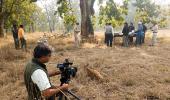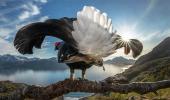From hippos playing in the lake shallows, to a fight between a cheetah and dogs, photographers have scoured the planet to highlight it's wondrous sights.
The Natural History Museum’s Wildlife Photographer of the Year showcases the world’s best nature photography and photojournalism.
The overall winners will be announced on October 15 at an awards ceremony in the Natural History Museum’s iconic Hintze Hall.
Winning images are selected for their creativity, originality, technical excellence. This year’s competition attracted almost 50,000 entries from professionals and amateurs across 100 countries.
The exhibition at the Natural History Museum opens on October 18.
(Please click on the image for a full screen resolution)

A newborn hippo, just days old, was keeping close to its mother in the shallows of Lake Kariba, Zimbabwe, when a large bull suddenly made a beeline for them. He chased the mother, then seized the calf in his huge gape, clearly intent on killing it. After trying to drown it, he tried to crush it to death. All the while, the distraught mother looked on. Adrian’s fast reaction and fast exposure captured the shocking drama. Infanticide among hippos is rare but may result from the stress caused through overcrowding when their day-resting pools dry out. A male may also increase his reproductive chances by killing young that are not his, triggering females to go into oestrus, ready to mate with him. Photograph: Adrian Hirschi, Switzerland/Wildlife Photographer of the Year

A gentoo penguin -- the fastest underwater swimmer of all penguins -- flees for its life as a leopard seal bursts out of the water. Eduardo was expecting it. He had spotted the penguin, resting on a fragment of broken ice. But he had also seen the leopard seal patrolling off the Antarctic Peninsula coast, close to the gentoo’s colony on Cuverville Island. As Eduardo’s inflatable headed towards the penguin, the seal passed directly beneath the boat. Moments later, it surged out of the water, mouth open. The penguin made it off the ice, but the seal now seemed to turn the hunt into a game.Photograph: Eduardo Del Álamo/Wildlife Photographer of the Year

An ever-adaptable raccoon pokes her bandit-masked face out of a 1970s Ford Pinto on a deserted farm in Saskatchewan, Canada. In the back seat, her five playful kits trill with excitement. It was a sentiment shared by Jason, waiting silently in a nearby hide, who had been hoping for this chance every summer for several years. The only access into the car was through the small hole in the cracked safety glass of the windscreen. The gap was blunt‑edged but too narrow a fit for a coyote (the primary predator of raccoons in the area), making this an ideal place for a mother raccoon to raise a family. On this evening, she paused at the exit to check the surroundings just long enough for Jason to make his long twilight exposure. She then squeezed out to spend the night looking for food -- anything from fruit, nuts and eggs to invertebrates and small vertebrates. Photograph: Jason Bantle/Wildlife Photographer of the Year

In a rare encounter, a lone male cheetah is set upon by a pack of African wild dogs. Peter had been following the dogs by vehicle as they hunted in Zimanga Private Game Reserve, KwaZulu-Natal, South Africa. A warthog had just escaped the pack when the leading dogs came across the big cat. At first, the dogs were wary, but as the rest of the 12-strong pack arrived, their confidence grew, and they began to encircle the cat, chirping with excitement. The elderly cheetah hissed and lunged back at the mob, his left ear tattered, the right one pinned back in the ruckus. In a few minutes the spat was over as the cheetah fled. Photograph: Peter Haygarth/Wildlife Photographer of the Year

Hugging its flippers tight to its body, the Weddell seal closed its eyes and appeared to fall into a deep sleep. Lying on fast ice (ice attached to land) off Larsen Harbour, South Georgia, it was relatively safe from its predators -- killer whales and leopard seals -- and so could completely relax and digest. Shooting from an inflatable boat, Ralf tightly framed the sleeping seal, using the white backdrop of ice and soft light from the overcast sky to mimic the effect of a studio portrait. Converting his image to black and white accentuated the tones and textures of the seal’s dense mottled fur. Photograph: Ralf Schneider/Wildlife Photographer of the Year

A curious young grey whale approaches a pair of hands reaching down from a tourist boat. In San Ignacio Lagoon, on the coast of Mexico’s Baja California, baby grey whales and their mothers actively seek contact with people for a head scratch or back rub. The lagoon is one of three that comprise a grey whale nursery and sanctuary -- a key winter breeding ground for this surviving breeding population of grey whales, the eastern North Pacific ones. Whaling left the western population near extinction and wiped out the North Atlantic one. Persecution may also have led to the whales’ aggression towards boats and, in San Ignacio, a long‑lasting fear among local fishermen. But in the 1970s, a young whale approached a fisherman who dared to reach out and touch it. The trust between whales and humans built up, and today many females actively encourage their calves to interact with people. Photograph: Thomas P Peschak/Wildlife Photographer of the Year

IMAGE: When Carlos’s family planned a trip to Panama’s Soberanía National Park, sloths were high on their must-see agenda. They were not disappointed. For several days, from the observation deck of the park’s canopy tower, Carlos could photograph not only birds but also this brown-throated three-toed sloth -- the orange fur and the dark stripe on its back marking it as an adult male. It hung out in a cecropia tree, resting but occasionally moving, slowly, along a branch to reach new leaves. On this morning, with the forest cloaked in fog and the sloth on the move, Carlos decided on a new composition. Climbing down, he shot from a lower level but at an angle that would still show the sloth’s key features -- its three hooked claws clamped to the branch, its characteristic mask-like eye-stripe and its long, coarse fur. But by deliberately placing it in one part of the frame, he also captured the atmosphere of the forest -- ‘the sloth in its environment’. Photograph: Carlos Pérez Naval/Wildlife Photographer of the Year

On a night-time fieldtrip in the Peruvian Amazon rainforest, Frank spotted this bizarre-looking weevil clinging to a fern stem. Its glazed eyes showed it was dead, and the three antennae-like projections growing out of its thorax were the ripe fruiting bodies of a ‘zombie fungus’. Spreading inside the weevil while it was alive, the parasitic fungus had taken control of its muscles and compelled it to climb. When it was at a suitable height -- for the fungus -- the weevil held fast to the stem. Fuelled by the weevil’s insides, the fungus then started to grow fruiting bodies topped by capsules that would release a multitude of tiny spores to infect new prey. Shooting the weevil head on, to show its characteristic elongated snout, Frank isolated the fungus against a soft background to emphasise the capsules. By the next day, the spores had been released and the fungus had withered, its mission accomplished. Photograph: Frank Deschandol/Wildlife Photographer of the Year

From a distance, the beach scene at Alabama’s Bon Secour National Wildlife Refuge looked appealing: blue sky, soft sand and a Kemp’s ridley sea turtle. But as Matthew and the strandings patrol team got closer they could see the fatal noose around the turtle’s neck attached to the washed-up beach chair. The Kemp’s ridley is not only one of the smallest sea turtles -- just 65 centimetres (2 feet) long -- it is also the most endangered. Over the past 50 years, human activities – from egg and meat consumption to incidental capture in fishing nets – have greatly reduced its numbers. Photograph: Matthew Ware/Wildlife Photographer of the Year

On a bitterly cold morning on the Japanese island of Hokkaido, Diana came across a delightful scene. A flock of long-tailed tits and marsh tits were gathered around a long icicle hanging from a branch, taking turns to nibble the tip. Here, a Hokkaido long-tailed tit hovers for a split second to take its turn to nip off a beakful. If the sun came out and a drop of water formed, the tit next ‘in line’ would sip rather than nip. The rotation of activity was so fast-moving that it almost seemed choreographed. Two days later, Diana returned and found that, with temperatures still at -20°C (-4°F), the icicle remained and tits were still drinking from it. But when the sun came out and the ice began to melt, one long‑tailed tit chose to cling to the icicle instead of hovering. That instantly brought the performance to an end, as the icicle cracked and then crashed to the ground. Photograph: Diana Rebman/Wildlife Photographer of the Year

In the clear water of the Red Sea, a shoal of bigeye trevally circle 25 metres (80 feet) down at the edge of the reef. For the past 20 years Alex has travelled here, to Ras Mohammad – a national park at the tip of Egypt’s Sinai Peninsula – to photograph the summer-spawning aggregations of reef fish. ‘The big lure is that I always see something new,’ he says. This time, it was the high numbers of bigeye trevally. Their circling behaviour is a dating exercise prior to pairing up, though it also deters predators. Spawning gatherings like this are easily fished out – but not here, as the national park is a no-fishing marine reserve. Using a lens system with a 130‑degree angle of view, Alex captured the shape of the shoal against the deep blue water below, the iridescent angled fish reflecting the light from the sun and his strobes. Photograph: Alex Mustard/Wildlife Photographer of the Year

Pinned to a white wall are the skins of rattlesnakes. Surrounding them are signed bloody handprints -- triumphant marks of those who have skinned snakes at the annual rattlesnake round-up in Sweetwater, Texas. Each year tens of thousands of rattlesnakes are caught for this four‑day festival. In spring, wranglers use gasoline to flush the snakes out of their winter dens – a practice banned in many US states. They are kept in poor conditions before being brought to the festival and tossed into snake pits. They are then decapitated as entertainment for festival-goers, who pay to skin them. Proponents of the roundups claim they are needed to control the populations of venomous snakes to ensure the safety of people, pets and livestock. But opponents regard round-ups as an ecologically damaging, unsustainable and inhumane practice. What Jo-Anne found most unsettling about this image was ‘that so many of the bloodied handprints belonged to children’. Photograph: Jo-Anne McArthur/Wildlife Photographer of the Year














